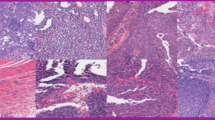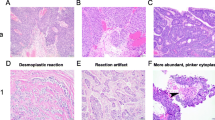Abstract
This paper extends the line of research that considers the application of Artificial Neural Networks (ANNs) as an automated system, for the assignment of tumors grade. One hundred twenty nine cases were classified according to the WHO grading system by experienced pathologists in three classes: Grade I, Grade II and Grade III. 36 morphological and textural, cell nuclei features represented each case. These features were used as an input to the ANN classifier, which was trained using a novel stochastic training algorithm, namely, the Adaptive Stochastic On-Line method. The resulting automated classification system achieved classification accuracy of 90%, 94.9% and 97.3% for tumors of Grade I, II and III respectively.
Preview
Unable to display preview. Download preview PDF.
Similar content being viewed by others
References
Almeida, L.B., Langlois, T., Amaral, L.D., Plankhov, A.: Parameter adaption in stohastic optimization. On-Line Learning in Neural Networks, pp. 111–134 (1998)
Belacel, N., Boulassel, M.R.: Multicriteria fuzzy assignment method: a useful tool to assist medical diagnosis. Artificial Intelligence in Medicine, 21, 201–207 (2001)
Choi, H.-K., Vasko, J., Bengtsson, E., Jarkrans, T., Malmstrom, U., Wester, K., Busch, C.: Gradingof transitional cell bladder carcinoma by texture analysis of histological sections. Analytical Cellular Pathology 6, 327–343 (1994)
De Prez, C., De Launoit, Y., Kiss, R., Petein, M., Pasteels, J.-L., Verhest, A.: Computerized morphonuclear cell image analysis of malignant disease in bladder tissues. Journal of Urology 143, 694–699 (1990)
Hornik, K.: Multilayer feedforward networks are universal approximators. Neural Networks 2, 359–366 (1989)
Jarkrans, T., Vasko, J., Bengtsson, E., Choi, H.-K., Malmstrom, U., Wester, K., Busch, C.: Gradingof transitional cell bladder carcinoma by image analysis of histological sections. Analytical Cellular Pathology 18, 135–158 (1995)
Jonathan, I.E., Mahul, B.A., Victor, R.R., Mostofi, F.K.: R Victor, and F.K Mostofi (transitional cell) neoplasms of the urinary bladder. The American Journal of Surgical Pathology 22(12), 1435–1448 (1998)
Magoulas, G.D., Plagianakos, V.P., Vrahatis, M.N.: Global learning rate adaptation in on–line neural network training. In: Proceedings of the Second International Symposium in Neural Computation, May 23-26, Berlin, Germany (2000)
Magoulas, G.D., Plagianakos, V.P., Vrahatis, M.N.: Adaptive stepsize algorithms for on-line training of neural networks. Nonlinear Analysis, T. M. A. 47(5), 3425–3430 (2001)
Magoulas, G.D., Plagianakos, V.P., Vrahatis, M.N.: Hybrid methods using evolutionary algorithms for on–line training. In: INNS–IEEE International Joint Conference on Neural Networks (IJCNN), Washington, D.C., U. S. A, July 14-19, vol. 3, pp. 2218–2223 (2001)
Magoulas, G.D., Plagianakos, V.P., Vrahatis, M.N.: Improved neural networkbased interpretation of colonoscopy images through on-line learning and evolution. In: Dounias, D., Linkens, D.A. (eds.) European Network of Excellence on Intelligent Technologies for Smart Adaptive Systems, pp. 38–43 (2001)
Ooms, E., Anderson, W., Alons, C., Boon, M., Veldhuizen, R.: Analysis of the performance of pathologists in grading of bladder tumors. Human Pathology 14, 140–143 (1983)
Parker, S.L., Tony, T., Bolden, S., Wingo, P.A.: Cancer statistics. Cancer Statistics 1997. CA Cancer, J. Clin. 47(5), 5–27 (1997)
Plagianakos, V.P., Magoulas, G.D., Vrahatis, M.N.: Tumor detection in colonoscopic images using hybrid methods for on–line neural network training. In: Papadourakis, G.M. (ed.) Neural Networks and Expert Systems in Medicine and Healthcare (NNESMED), Technological Educational Institute of Crete, Heraklion, pp. 59–64 (2001)
Raudys, S.J., Jain, A.K.: Small sample size effects in statistical pattern recognition: Recommendations for practitioners. IEEE Transactions on Pattern Analysis and Machine Intelligence, 252–264 (1991)
Schraudolf, N.N.: Gain adaptation in stochastic gradient descend (1999)
Spyridonos, P., Cavouras, D., Ravazoula, P., Nikiforidis, G.: Neural network based segmentation and classification system for the automatic grading of histological sections of urinary bladder carcinoma. Analytical and Quantitative Cytology and Histology 24, 317–324 (2002)
Suton, R.S.: Adaptingbi as by gradient descent: an incremental version of delta bar-delta. In: Proc. 10th National Conference on Artificial Intelligence, pp. 171–176. MIT Press, Cambridge (1992)
Suton, R.S.: Online learningw ith random representations. In: Proc. 10th International Conference on Machine Learning, pp. 314–321. Morgan Kaufmann, San Francisco (1993)
White, H.: Connectionist nonparametric regression: Multilayer feedforward networks can learn arbitrary mappings. Neural Networks 3, 535–549 (1990)
Author information
Authors and Affiliations
Editor information
Editors and Affiliations
Rights and permissions
Copyright information
© 2003 Springer-Verlag Berlin Heidelberg
About this paper
Cite this paper
Tasoulis, D.K. et al. (2003). Urinary Bladder Tumor Grade Diagnosis Using On-line Trained Neural Networks. In: Palade, V., Howlett, R.J., Jain, L. (eds) Knowledge-Based Intelligent Information and Engineering Systems. KES 2003. Lecture Notes in Computer Science(), vol 2773. Springer, Berlin, Heidelberg. https://doi.org/10.1007/978-3-540-45224-9_29
Download citation
DOI: https://doi.org/10.1007/978-3-540-45224-9_29
Publisher Name: Springer, Berlin, Heidelberg
Print ISBN: 978-3-540-40803-1
Online ISBN: 978-3-540-45224-9
eBook Packages: Springer Book Archive




